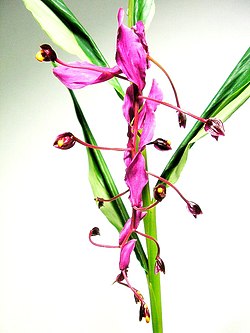| Ginger family Temporal range: | |
|---|---|
 | |
| Red torch ginger ( Etlingera elatior ) | |
| Scientific classification | |
| Kingdom: | Plantae |
| Clade: | Tracheophytes |
| Clade: | Angiosperms |
| Clade: | Monocots |
| Clade: | Commelinids |
| Order: | Zingiberales |
| Family: | Zingiberaceae Martinov [2] |
| Type genus | |
| Zingiber [ citation needed ] Boehm. | |
| Genera [3] | |
58 – see text | |
Zingiberaceae, the ginger family, is a family of flowering plants containing 58 genera and about 1600 described species distributed globally in the tropics and subtropics. [4] [5] They are aromatic perennial herbs with creeping rhizomes, sometimes tuberous. Many of the family's species are important ornamental, spice, or medicinal plants. Ornamental genera include the shell gingers ( Alpinia ), Curcuma , Hedychium , Kaempferia , and torch-gingers ( Etlingera ). Spices include ginger ( Zingiber officinale ), Thai ginger ( Alpinia galanga and others), melegueta pepper ( Aframomum melegueta ), myoga (Zingiber mioga), korarima (Aframomum corrorima), turmeric (Curcuma), and cardamom ( Amomum and Elettaria species). [6]



